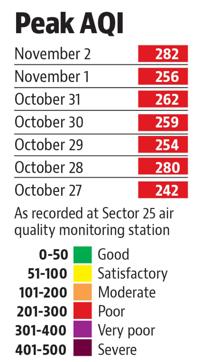Chandigarh’s air quality deteriorates further
AQI recorded higher than what it was day after Diwali, to worsen amid cloudy weather and falling mercury
Air quality of the city is showing no sign of improvement.

The Air Quality Index (AQI) peaked at 282 at the monitoring station in Sector 25 around 1pm on Saturday, worse than what was recorded even post Diwali.
The continuos ambient air quality monitoring station in Sector 25 is the only one in the city that provided realtime data. AQI is a numerical scale used for reporting day-to-day air quality with regard to human health and the environment.
The AQI was recorded at 280 at 9pm on October 28, a day after Diwali. It came down in the following days, but surged once again on Saturday.
According to Central Pollution Control Board (CPCB) bulletin, the average AQI recorded at the monitoring station on October 28 was 267, and reached 279 on Saturday. An AQI between 201-300 is classified as poor. Prolonged exposure to such air can cause breathing discomfort to people. The particulate matter has a toxic effect on lungs similar to tobacco smoke.
According to the officials concerned, the air quality can get worse in the coming days.
“Even looking at the monitoring equipment isn’t necessary. Pollution can be seen in the air,” said TC Nautiyal, member secretary of the Chandigarh Pollution Control Committee (CPCC). “There are no winds in the city and particulate matter isn’t getting dispersed. The city desperately needs rains, or the air quality will get even poorer.”
Nautiyal said even though AQI spiked post Diwali, bursting of crackers wasn’t the primary reason. “Stubble burning, which is rampant in the region, needs to stop to ensure that AQI doesn’t shoot up this time of the year in future. Also, people need to cut down on using polluting vehicles and adopt alternative means, like cycling.”

No winds, rain till November 6
A weak system of western disturbances was active in the city on Saturday, which according to the India Meteorological Department (IMD) director Surender Paul led to worsening of the situation.
“Due to an anticyclonic movement, there is no vertical circulation of air and particulate matter is not getting dispersed,” he said. Due to western disturbances, the sky remained cloudy, making the maximum temperature fall three degrees below normal, which led to a further inversion of temperature.”
Paul said cooler temperatures automatically increase the AQI, and it will remain this way till November 6.
“A stronger system of western disturbances is expected around November 6. Winds blowing at speeds around 30km/hour and light to moderate rains can be expected on November 6 and November 7,” he said.
Meanwhile, visibility dropped down to between 2-3 km on Saturday. According to IMD scientists, it was between 4-5 km before Diwali, and high percentage of moisture and pollutants in the air had led to the formation of haze in the city. “It is most visible in deserted places, especially during mornings. People travelling on national highways should be cautious,” said the weatherman.
However, despite the high AQI, the Post Graduate Institute of Medical Education and Research (PGIMER) has not reported any rise in complaints of pulmonary diseases.
Dr D Behera, head of the department of pulmonary medicine at the PGIMER, said: “Pulmonary diseases take some time to manifest. We are only receiving a spike in breathing problems that are treatable.”
Talking about what precautions should be taken in the given circumstances, he said: “People suffering from asthma, chronic obstructive pulmonary disease, lung fibrosis or any other respiratory infection must stay indoors. They should go out only if it is extremely important and should not forget to wear a mask.”






